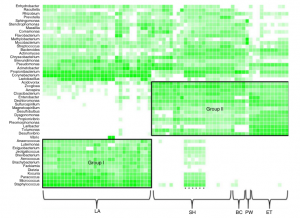One of the most commonly quoted bits of information about the microbiome is that bacteria outnumber human cells 10 to 1. That figure has been widespread in media and promotional posters. It’s even on a a poster I got at ASM visualizing the basics of the human microbiome. But I have had a number of …
I’ve been seeing a lot of media articles recently on applications of gut microbiome research in health in terms of pills and probiotics. One article talks about a start-up that is trying to create various pills filled with bacteria associated with different positive health effects. Of course, there is the question if such probiotics will thrive in …
Our food comes into contact with a lot of different materials and machines before it reaches our plates. The agriculture industry tries hard to ensure proper food safety by testing random representative samples of each batch of produce or food product before sending it out for distribution. They cannot send out the batch until they …
The list of things that are sterile is shrinking as DNA sequencing methods become more sensitive and are able to pick up microbial signals in even the sparsest environments. A news article in the Times discusses research on the microbiome of the human womb and the fact that it is not actually as sterile as …
Often on this blog, we talk about biofilms in water systems or water-borne pathogens. Even when we discuss the drinking water microbiome, it is seldom with a focus on any particularly beneficial bacteria. Although there has been some discussion about what essentially amounts to probiotics for water, there seems to be little literature in the area …
The Joint Commission recently released new standards for antibiotic stewardship for field review. They aim to get more hospitals and institutions thinking about antibiotic stewardship programs and how their prescribing habits affect antibiotic resistance. Although it seems there may be opposition by some clinicians (as there always is with any change), hopefully antibiotic stewardship standards will become …
A review by Maddox et al came out earlier this year on antimicrobial resistance in horses. Livestock are a common source of antimicrobial resistance genes since so many antimicrobials are used on a regular basis to raise these animals. Too slowly, laws are coming into place restricting antimicrobial use in livestock so that only when animals are …
Autumn is not just a beautiful season in which multicolored leaves fall to the ground from their branches. It is also a good time for all kinds of microbes to flourish with the new addition of delicious leaf litter nutrients. A new paper from Irga et al studies the connection between the fungi found on leaf litter and …
As buildings move forward in an attempt to become more “green,” it is important to continue to assess how the microbiology changes with these new systems. A recent study from Keely et al used high-throughput pyrosequencing to look at what microbes live in the different points in grey water systems. The sampling efforts were split into …
A blog post from the Scottish Wildlife Trust by Ed Taylor discusses the importance of greenspace in Scotland’s suburban and urban areas. It’s part of a “50 for the Future” series that suggests 50 things that should occur in Scotland over the next 50 years to benefit both people and wildlife. As suburban areas are …





